Discover top guides, trends, tips and expertise from AIO Writers
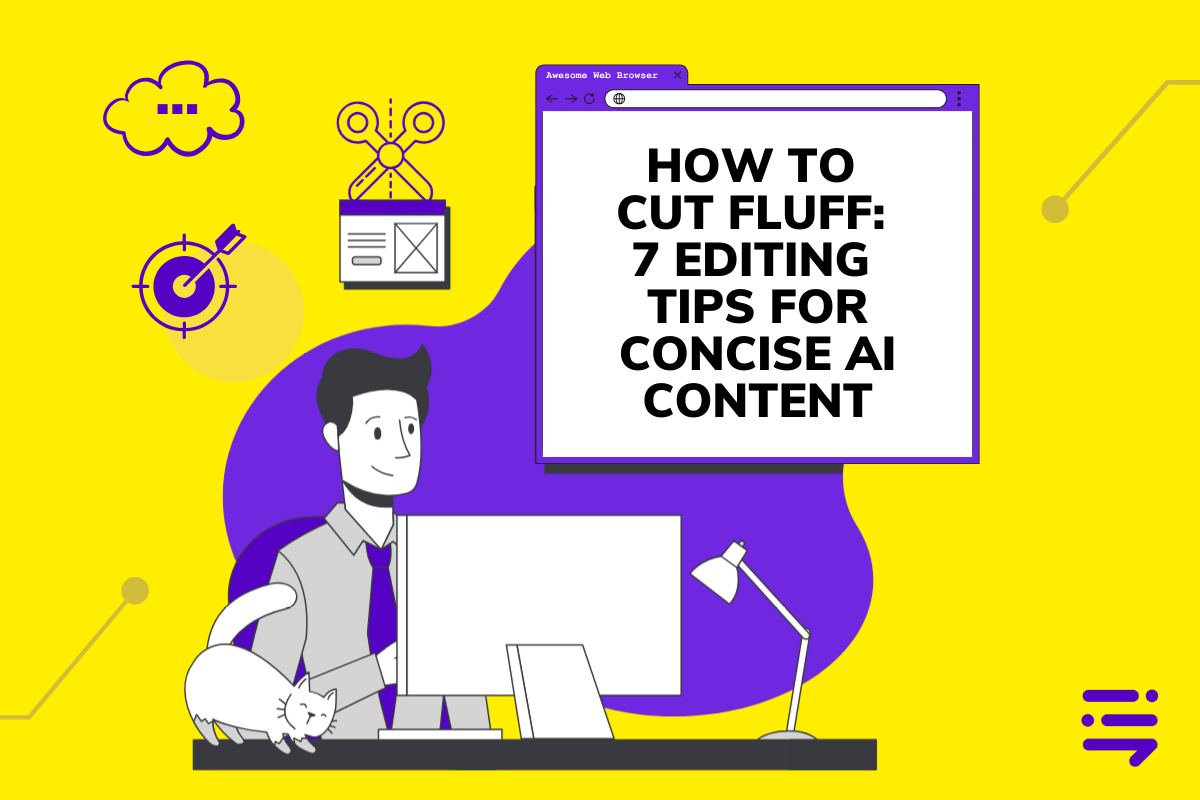
Did you know that humans have an average attention span of only eight seconds?
Yup, we now have shorter attention spans than a goldfish.
And with all the digital noise around us, it can be difficult for people to focus on one thing and not swipe to the next.
Unless you do something to keep them engaged.
One way to keep your reader on your page is to cut the fluff.
Fluff is often off-topic, unnecessary, difficult to read, and boring to readers. By removing these fillers, you can catch your readers’ limited attention span with concise, engaging content.
Let’s get started.
What is Fluff in Written Content?
Fluff refers to words, phrases, or sentences that don’t add value to the overall message of the piece. It’s often used as filler material or simply as a way of making an article appear longer than necessary.
What Does Fluff Look Like?
Fluff usually takes on one of two forms:
1. Redundant Language
Redundant language includes phrases like “in order to” and “due to the fact that”. These words don’t add anything new or interesting. They just take up space.
2. Irrelevant Information
This is information that doesn’t contribute directly toward the main point of an article. Examples are anecdotes, tangents, and personal opinions not related to the topic at hand.
Another type of fluff is overusing adjectives and adverbs. Here’s an example:
Fluffy: “He ran extremely quickly across the field”
Concise: “He sprinted across the field”
Another example:
Fluffy: “The dog barked loudly”
Concise: “The dog barked”
And another:
Fluffy: “She was as graceful as a swan gliding through water”
Concise: “She moved gracefully”
The bolded words can be removed without any effect on the clarity or meaning of the sentence.
Expletives, adverbs, adjectives, and other cutesy language have their place in writing, but they must be used in moderation when writing web content.
Why is It Important to Remove Fluff from Your Articles?
Removing fluff makes your writing more concise and easier for readers to digest. It helps ensure accuracy since facts are not lost among irrelevant details.
Besides obscuring facts, fluff makes it difficult for readers to maintain interest and engage with the content.
Key Takeaway: Removing fluff from your writing helps make it more concise and easier to read. To avoid fluff, ask yourself if each sentence adds value, read aloud for clarity and accuracy, and cite only relevant sources.
7 Tips for Cutting Fluff in Long-Form Blog Articles
The best way to avoid writing fluff is by being aware of what content adds value and what doesn’t. Before adding any sentence to your work, ask yourself whether it adds something meaningful or it only pads the piece.
Here are 7 tips for cutting fluff in long-form blog articles:
1. Start with an Outline
It is harder to go off-topic if you write with the guide of an outline. An outline will help organize your thoughts and keep you focused on your article’s main points.
The RankWell long-form content writer takes the pain out of writing blog post outlines. All you need is the keyword you want your article to rank for and a few lines of text to give the AI additional context.
After opening your project in the BrandWell app, you will see this screen:
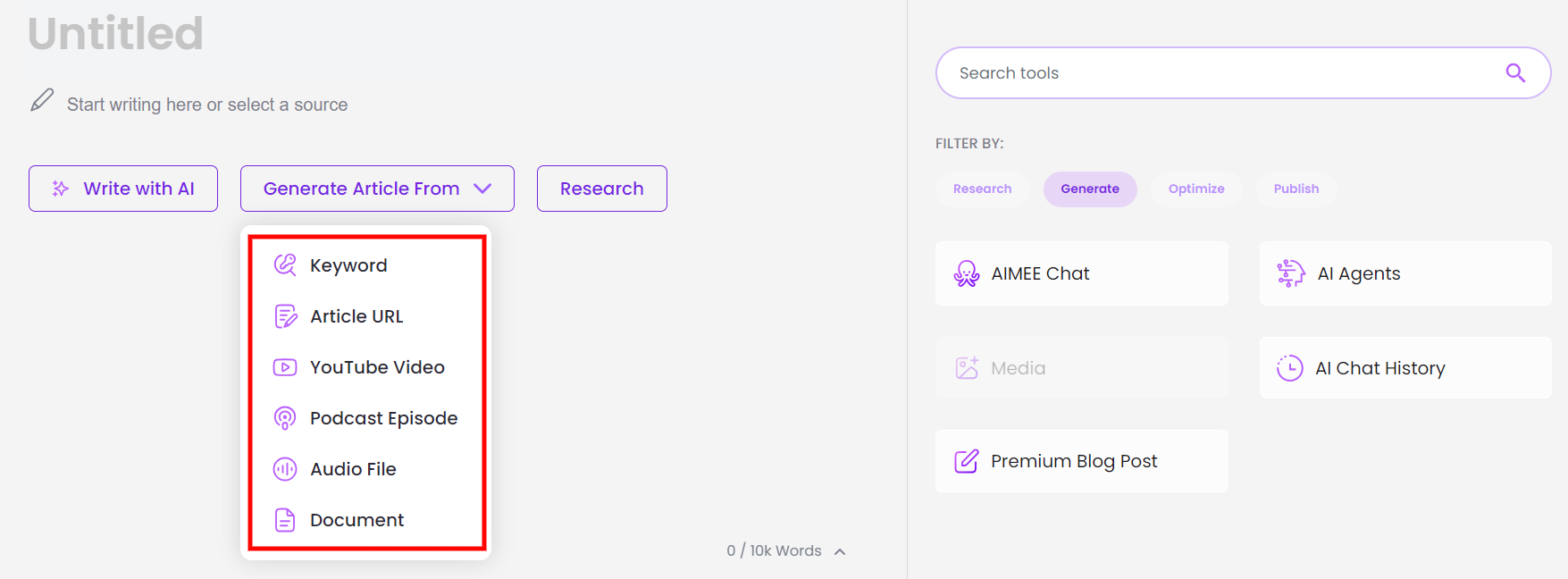
Whatever source you choose for generating your blog post, RankWell will automatically generate your article’s outline based on its Deep Research — which involves crawling the top of Google and creating a massive database of all the important information to be included in your post.
You can modify this outline later if you feel that the AI missed some important points.
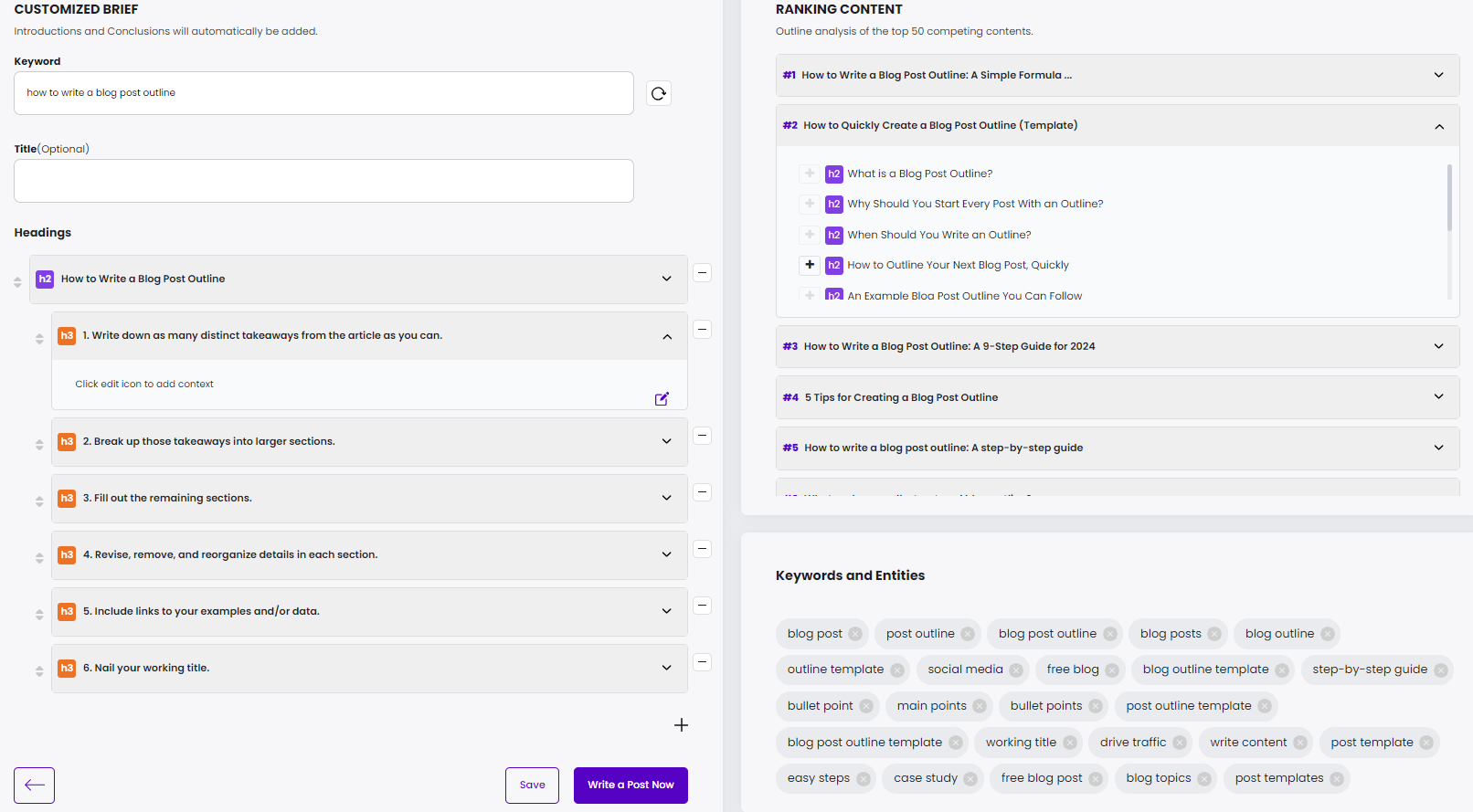
When you are satisfied with the outline, hit the Write a Post Now button.
2. Get to the Point, FAST
You don’t need five long paragraphs to introduce your topic. Long introductions risk boring readers before they get to the information they are after. So get to the meat of the matter, FAST, using short sentences and paragraphs.
Your introduction needs to quickly tell readers what questions you will be answering in the piece. Of course, you may want to do this in a way that encourages readers to read on but don’t take too long with it.
3. Cut Out Unnecessary Words
Take a look at each sentence and ask yourself if all the words are necessary for conveying the intended meaning. If not, cut them out.
This will help streamline your writing and make the information more accessible. Those unnecessary, redundant details and irrelevant information distract readers from understanding what you’re trying to say.
Look for areas where you have used intensifiers, adverbs, and adjectives. These words are often unnecessary. Words like really, somewhat, fairly, rather, quite, and very rarely improve a sentence.
4. Replace Jargon with Simple, Everyday Words
When you sit down to write an article, your goal should not be to sound knowledgeable and sophisticated. It should be to convey your message as simply as possible so that it is easily understood.
The best way to do this is to avoid jargon and use simple, direct language. Unless you are addressing a professional audience, like doctors, engineers, architects, or lawyers, avoid jargon.
5. Chop Big Words and Long Phrases
Jargon has the same effect on your content as big words. Don’t use a big word if there is a small, simpler one. Here are 20 commonly used big words that could be replaced with smaller/simpler ones:
- Utilize -> use
- Ameliorate -> improve/help
- Alleviate -> ease/reduce
- Approximately -> about
- Attempt -> try
- Commence -> start
- Detrimental -> damaging/harmful
- Disseminate -> spread
- Emphasize -> stress
- Expeditiously -> quickly
- Objective -> aim/goal
- Proportion -> part
- Reimburse -> repay/pay back
- Residence -> home
- Substantial -> large/great
- Sufficient -> enough
- Ultimately -> finally
- Visualize -> see
- Unoccupied -> empty
- Notwithstanding -> despite/still/yet
While big words don’t add to the word count, they make the information harder to understand. What pads the article are long phrases that can be replaced with one word or two.
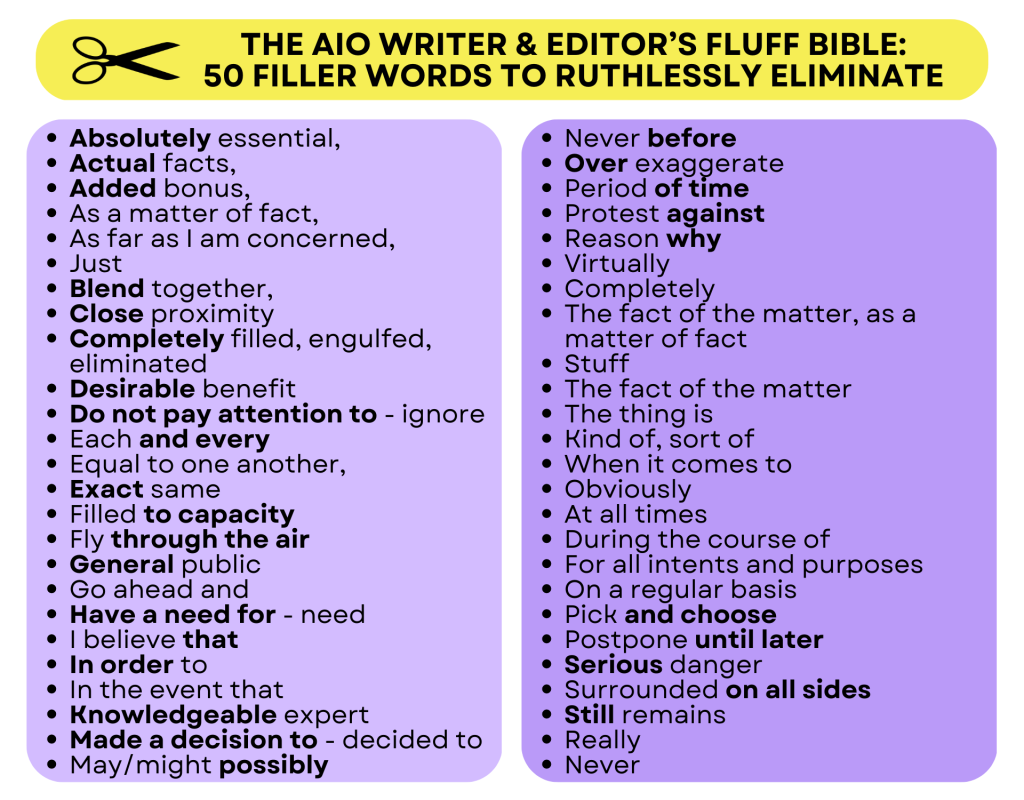
Here are a few other examples:
- To the extent that -> if/when
- That being the case -> if so
- A large number of -> many/most (or just state the number)
- On numerous occasions -> often
- On the grounds that -> because
- Of the opinion -> think
- With the minimum of delay -> quickly
- With reference to -> about
- The question as to -> whether
- On behalf of -> for
If a reader does not understand the meaning of a word, it’s meaningless to them. This means if your piece is laden with jargon and big words, the whole article is unintelligible to your audience.
6. Check Your Grammar and Punctuation
Bad grammar and misspellings reflect badly on you and take attention away from the information you are sharing, while poor punctuation makes your article harder to read and understand.
Good punctuation makes your writing clearer and more precise. It saves words as you won’t need to expand a point with an extra sentence or two to get it across.
7. Read Aloud When Proofreading
Reading aloud helps to catch typos and other small errors you may have missed. It focuses your attention on the work you are proofing, which helps to identify areas where sentences might be wordy or difficult for readers to understand.
Key Takeaway: Cutting back on fluff in AI content is essential for readability and comprehension.
After trimming all that fluff, your article should now be ready for on-page SEO.
Before you leave the editor, remember to save the changes you have made.
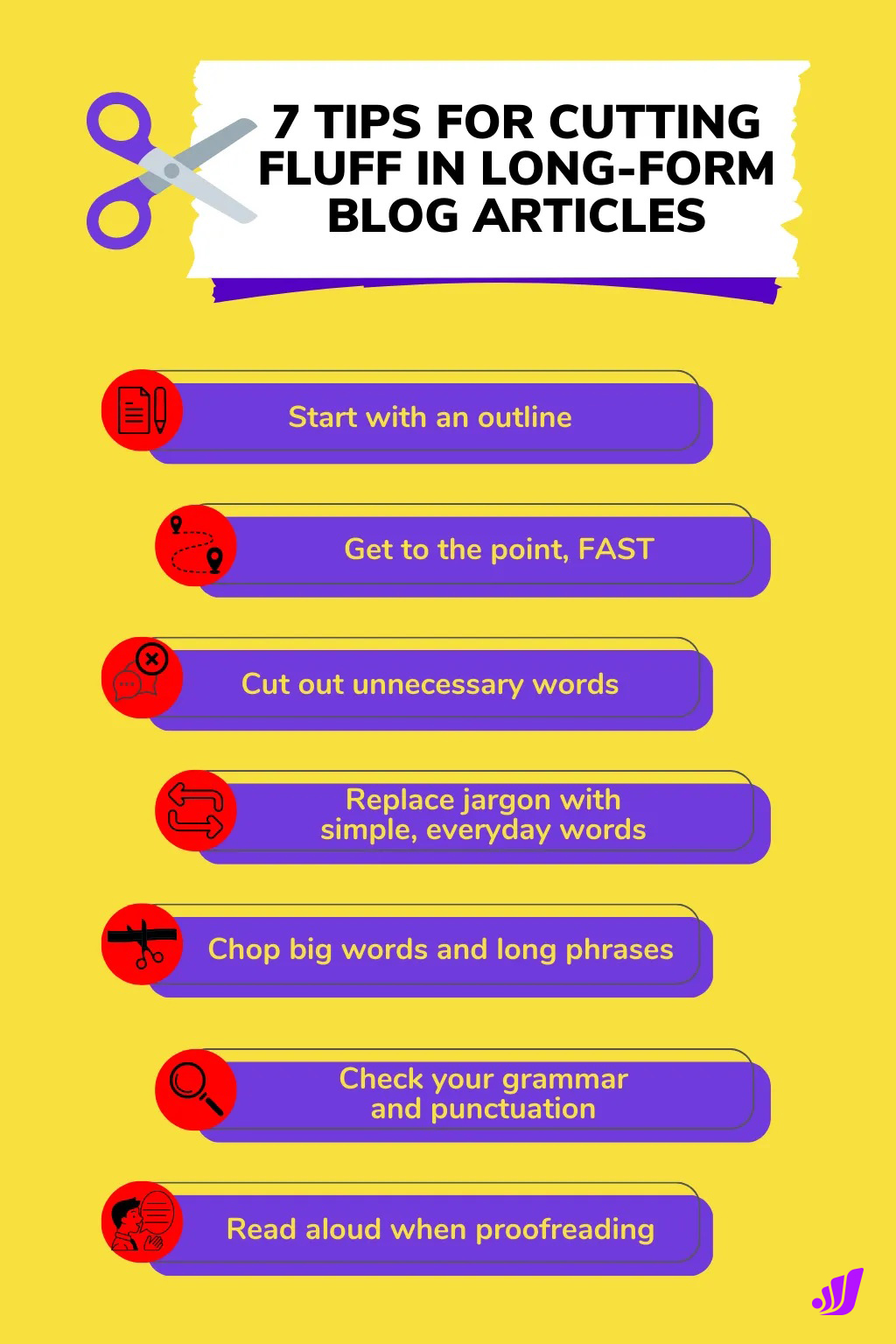
How to Edit Sentences for Readability and Conciseness
Now let me show you how to cut fluff from entire sentences.
There are two ways to cut fluff: formatting paragraphs and breaking up long sentences.
The first step is to format content correctly with proper spacing. As you can see in the paragraph below, it has three long sentences that make it difficult to read. Breaking up text-heavy paragraphs not only allows the text to breathe but will also help you find fluff more easily.

You can split this paragraph into two or three sections.

The next step is to find long sentences and break them up.
Let’s look at the first sentence.

Before: “Utilizing analytics and reporting tools can help businesses make data-driven decisions to optimize their marketing strategies by providing insight into customer behavior.”
This sentence has 23 words! Any sentence with more than 15 to 18 words is considered too long for online content.
A quick tip: One way to spot long sentences is to read them out loud. If you run out of breath before reaching the end, then that sentence is too long.
So how do we break a long sentence into smaller pieces?
Again, read the sentence out loud and you’ll find where a complete thought ends and where another one starts.
In our example, “utilizing analytics and reporting tools can help businesses make data-driven decisions” is one complete thought that could be its own sentence.

The second part of the sentence is not a complete sentence so I edited it to: “These tools will help you optimize your marketing strategy by providing insight into customer behavior.”

Note that I changed the POV from the third-person to the second-person perspective so the content talks to the reader instead of about them.

Going back to the first sentence, “utilizing” is considered a fluff word in this instance. It doesn’t add anything to the sentence so you can just delete it.
Now we have two sentences that speak directly to the reader instead of one long sentence that talks about them:
After: “Analytics and reporting tools can help you make data-driven decisions about your business. These tools will help you optimize your marketing strategy by providing insight into customer behavior.”

Let’s proceed to the next paragraph and see where we can cut more fluff.

You can see right away that the first sentence is repetitive — it’s almost a duplicate of the previous sentence. If a sentence doesn’t add any value, just delete it.
Finally, a few more edits in the last sentence for better flow.
- Changed “In this section” to “Next” to make it a little more succinct.
- Changed “analytics and reporting tools” to “their” since the phrase was already mentioned twice in this section and the reader already knows what I’m talking about.
- Changed “we will” to “we’ll” as contractions make your content sound more conversational.

The Importance of Paragraph Structure for Cutting the Fluff
Proper formatting plays a crucial role in making your content readable and enjoyable. To remove fluff, break up long paragraphs into smaller sections using appropriate spacing. Write clear headings to guide readers through the text effortlessly.
When you’re editing AI-generated content, make sure each paragraph focuses on one main idea. This helps readers understand what that section is about without getting lost in fluff writing.
Consider these tips:
- Maintain an average length of 1-3 sentences per paragraph.
- Incorporate transition words like “however,” “additionally,” or “furthermore” to create a smooth flow between ideas.
Breaking Up Long Sentences
Lengthy sentences can be challenging to follow. By dividing complex thoughts into smaller pieces, you create an effortless reading experience that keeps audiences engaged.
Here are a few tips on how to split long sentences.
- Look for subordinating conjunctions: Subordinating conjunctions like “although”, “since”, “when”, or “because” connect an independent clause to a dependent clause. Sometimes, the subordinating conjunction and its phrase can be edited or deleted to trim a sentence.
Example: Although fluff writing may seem harmless, it negatively impacts your content’s effectiveness.
Improve Reader Experience with Concise, More Readable AI Content
AI content suffers from the same issues of wordiness and fluff that you get with human-written content. That’s why you should treat AI content as a baseline and not the final draft. While the content generated by RankWell is already very good, it can still be improved.
Lean, fluff-free content is easier to read and understand – both of which are the aims of SEO blogging. Where possible, use fewer words to get your point across. Avoid repetition, cutesy language, and other tricks that only serve to pad your articles.
Join 1,000’s of other writers and publishers who are using BrandWell content marketing platform to produce nearly ready-to-publish articles, saving you thousands of dollars and up to 10X production time. Streamline your growth marketing strategy and save money and time with BrandWell today.

UNLOCK YOUR POTENTIAL
Long Headline that highlights Value Proposition of Lead Magnet
Grab a front row seat to our video masterclasses, interviews, case studies, tutorials, and guides.



